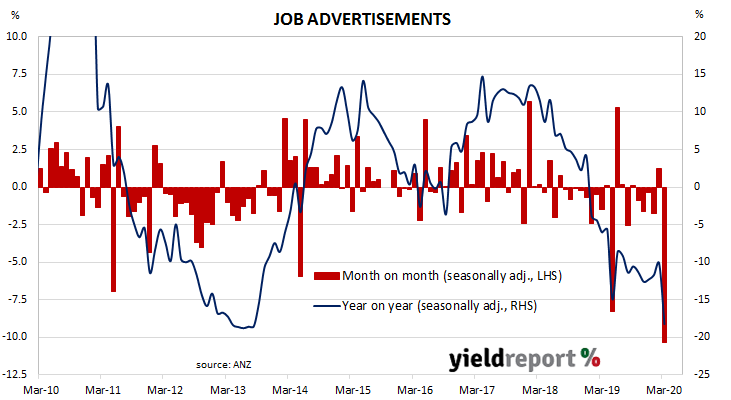From mid-2017 onwards, year-on-year growth rates in the total number of Australian job advertisements consistently exceeded 10%. That was until mid-2018 when the annual growth rate fell back markedly. 2019 was notable for its reduced employment advertising, along with a reversal of the gains in 2017 and 2018. The first two surveys of 2020 provided modest increases but the latest report is undoubtedly a sign of things to come.
According to the latest ANZ figures, total advertisements fell by 10.3% in March on a seasonally-adjusted basis, following a 1.2% rise in February after that month’s figures were revised up. On a 12-month basis, total job advertisements were 18.2% lower than in March of last year, a large deterioration from February’s comparable figure of -10.2%.
ANZ senior economist Catherine Birch said, “Most of the fall occurred over the second half of March as Australian COVID-19 cases escalated, restrictions on movement tightened and shutdowns of non-essential services broadened.”
 Domestic bond yields rose markedly at the long end following a “risk-on” theme present in offshore markets and large rises in the afternoon after the RBA’s April monetary policy statement. By the end of the day, 3-year ACGB yields remained unchanged at 0.25%, fixed by the RBA, while the 10-year yield had jumped by 15bps to 0.91% and the 20-year yield finished 16bps higher at 1.60%.
Domestic bond yields rose markedly at the long end following a “risk-on” theme present in offshore markets and large rises in the afternoon after the RBA’s April monetary policy statement. By the end of the day, 3-year ACGB yields remained unchanged at 0.25%, fixed by the RBA, while the 10-year yield had jumped by 15bps to 0.91% and the 20-year yield finished 16bps higher at 1.60%.
Prices of cash futures contracts moved to reflect a slight softening of rate-cut expectations, although the RBA’s latest rate cut to 0.25% has almost ruled out further rate cuts, with members of the RBA Board having agreed after the previous rate cut “the cash rate was now at its effective lower bound.” By the end of the day, May contracts implied a rate cut down to zero as a 48% chance, down from the previous day’s 52%. June contracts implied a 41% chance of such a move, down from 45%. Another rate reduction was not seen as being any more likely in later months of 2020; December contracts implied a 44% chance of a rate cut down to zero.

